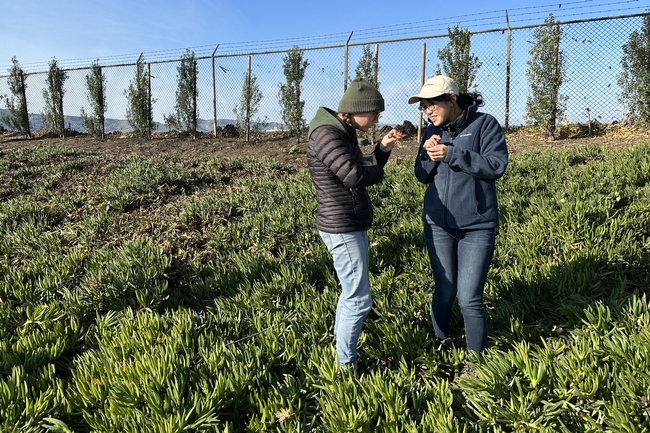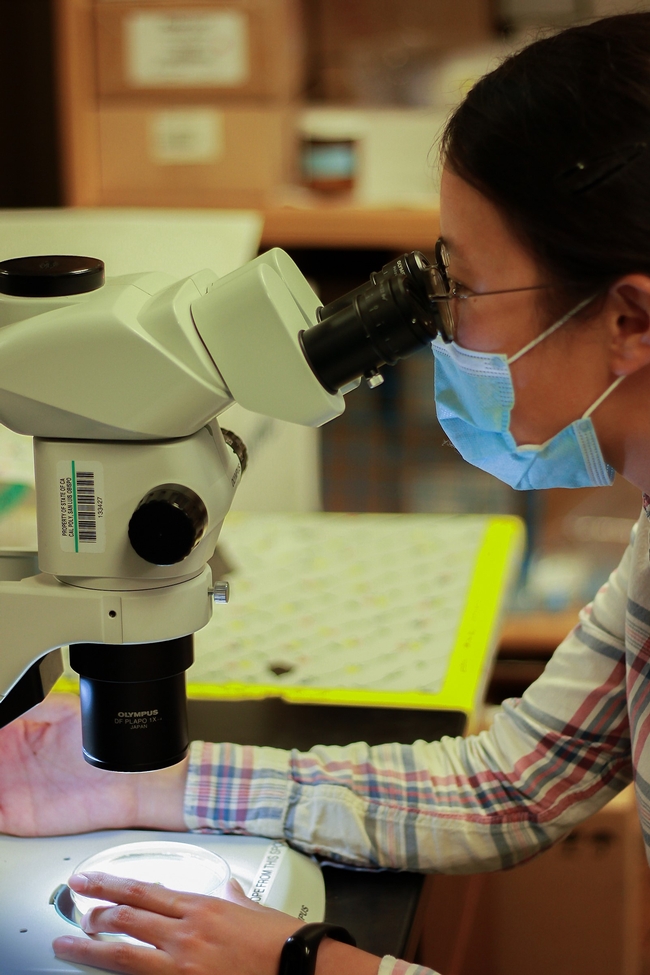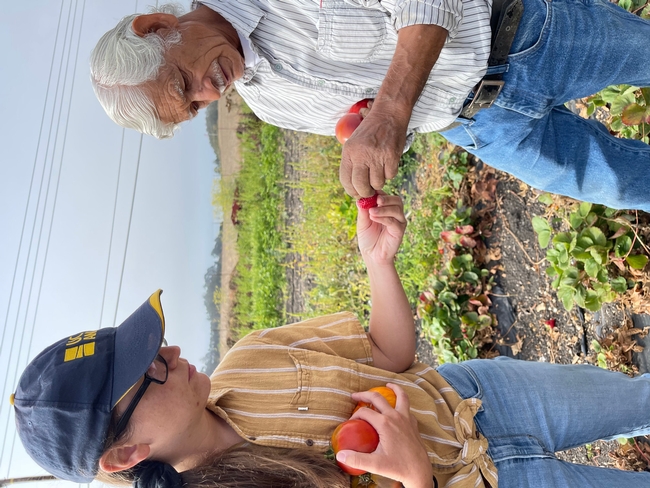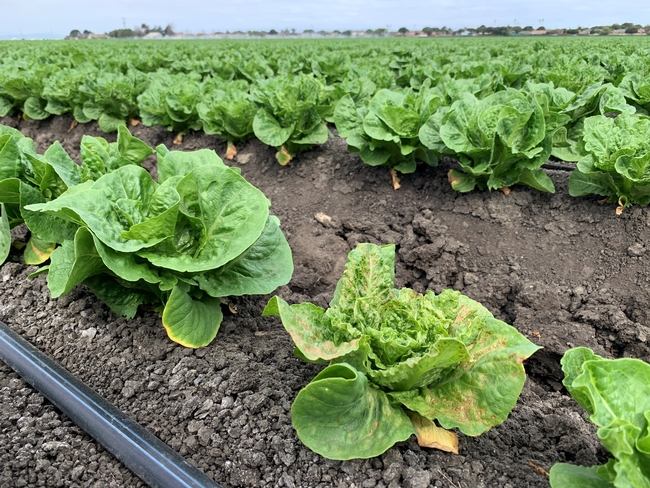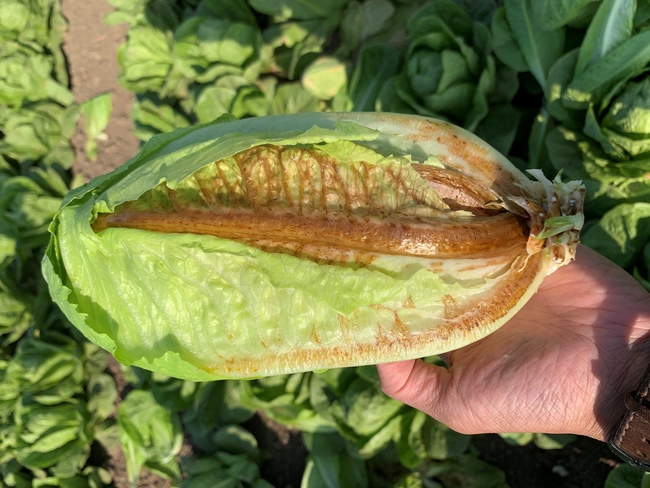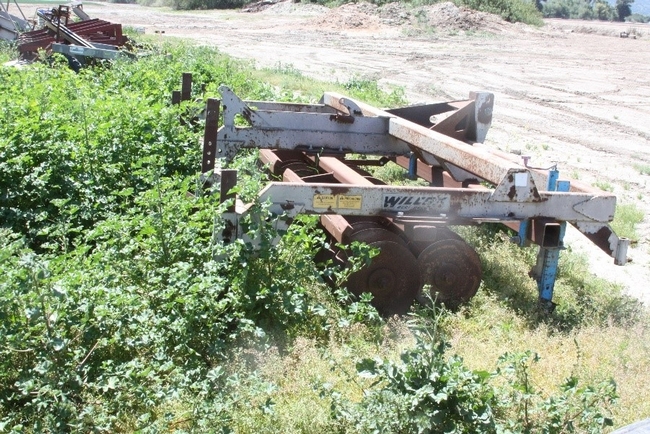
Posts Tagged: lettuce
New UCCE advisors bring fresh ideas to protect lettuce from INSV, Pythium wilt
Salinas Valley lettuce growers lost about $150 million in 2022 due to diseases
A stormy winter could portend another devastating year for the lettuce industry in the Salinas Valley, which saw approximately $150 million in lost gross revenue in 2022 due to INSV (impatiens necrotic spot virus) and associated diseases. Recent drenching rains might mean more weeds – overwintering “reservoirs” for the tiny insect, the Western flower thrips, that carries INSV.
Or the extreme precipitation could benefit growers, as thrips in the soil – during their intermediate stage of development – might be drowned in the waterlogged fields.
As with so many aspects of the INSV crisis, the ultimate effects of flooded fields on thrips populations remain unknown.

“We don't know if thrips are just so persistent and so stable in that pupal stage that maybe they will emerge unaffected,” said Kirsten Pearsons, University of California Cooperative Extension integrated pest management farm advisor for Santa Cruz, Monterey and San Benito counties. “There's just so much about their biology and ecology in the Salinas Valley that we just don't know.”
The mystery of thrips, INSV and soilborne diseases (namely Pythium wilt) is why UC Agriculture and Natural Resources assigned Pearsons to the area last November and hired Yu-Chen Wang in October as UCCE plant pathology advisor for the three counties.
“They're stepping in at a critical moment,” said Richard Smith, the region's UCCE vegetable crop production and weed science advisor who retired in January after a 37-year career. “They've gotten grants funded already – and that's just incredible. They're hitting the ground running.”
Experienced in disease diagnosis and collaboration with growers and industry partners, Wang said her pathology background – paired with Pearsons' entomology expertise – will be crucial in addressing INSV and other diseases.
“It is important for Kirsten and me to work together and provide different insights for the vector and the pathogen, respectively,” Wang said.
‘It's going to take everything to get a crop'
One priority is untangling the dynamics of INSV and Pythium wilt co-occurrence – the subject of ongoing research by JP Dundore-Arias, a plant pathologist at California State University, Monterey Bay. While the vegetables may tolerate one disease or the other, their one-two punch often deals the lethal blow.
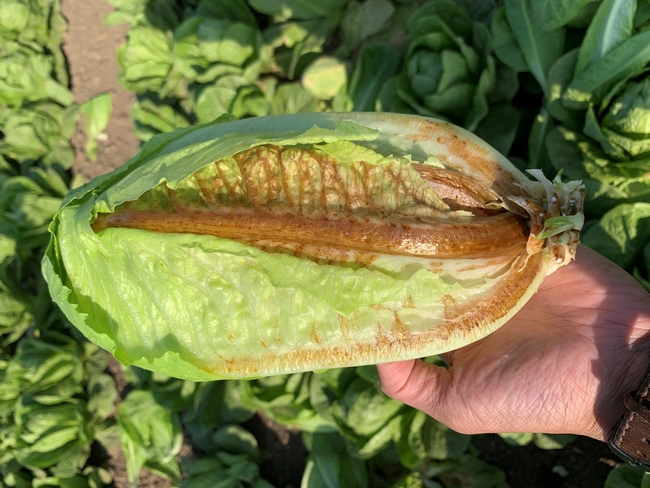
“The challenge is – which is why it's great to have Yu-Chen and Kirsten – is that we have so many problems now, whether it's Fusarium (wilt), or Verticillium (wilt), or Pythium, or INSV,” said Mark Mason, pest control adviser for Nature's Reward, which primarily grows lettuces on 5,000 acres across the Salinas Valley.
Mason said that co-infections on his crops (sometimes with three or four diagnosed diseases) make it difficult to assign monetary damages to a specific pathogen, but he noted he has seen fields with “100% loss.” According to the Grower-Shipper Association of Central California, about 11,500 acres were deemed not harvestable in 2022, representing 12% of lettuce industry acreage.
Given the gravity and complexity of the disease dilemma, Pearsons said she has been fielding calls from growers seeking new and better solutions – ways to improve existing tools, techniques borrowed from other crop systems, and additional biological or chemical means of control.
And although there are a couple of pesticides that manage the disease-carrying thrips reasonably well, growers and researchers are worried about their diminishing efficacy due to overuse. Plus, they only constitute a short-term fix.
“Managing the thrips will only reduce the amount of INSV that can get transmitted,” Pearsons explained. “You can kill 99.9% of the thrips, but you get one thrips that has INSV that enters a field, and now you have an infected lettuce plant. All of the thrips are going to come and they can spread it from there; pesticide slows things down, but it's not going to eliminate it.”
Finding disease-tolerant lettuce cultivars is a more sustainable approach. Trials conducted last year by Smith, Wang and others identified several varieties that appeared to hold up well to Pythium and INSV. While additional research could maximize their potential benefit, Wang said even the hardier cultivars will lose their resistance over time, and a multi-layered INSV strategy with “integrated management tools” is crucial.
“We realized, when this thing started happening, that we cannot spray our way out of this problem,” Mason said. “We need varieties; we need management practices; we need pesticides…it just seems like it's going to take everything to get a crop.”
Weeds key to disease control
An all-hands-on-deck approach helped control thrips-harboring weeds last winter. With fields drying out from January storms, Smith said communities must get back to weed management – with a focus on prominent weed hosts for INSV and neglected areas adjacent to farms. Hotspots of infection last year were traced to industrial lots that were overlooked during the weeding process.
“People can't lose sight of the fact that we still need to be controlling the weeds in key areas, because that's the reservoir of the virus during the winter,” Smith said. “We have to stay on task with that.”
Yet despite the diligent weed abatement, crop damage from INSV and Pythium was widespread in 2022, and Smith said it's “very possible” that high heat during the summer was a contributing factor to especially prevalent disease in fall. Thrips populations tend to thrive in warmer weather, Smith said, but much more research needs to be done to understand the basic biology of the insect, including how they acquire the virus and how they spread it.
High hopes for future
Pearsons cited the work of Daniel Hasegawa, a research entomologist with the U.S. Department of Agriculture, who leads teams in monitoring thrips populations in several locations across the Salinas Valley. Currently the counting of thrips on sticky card traps is done manually, but Pearsons and Mason mentioned the possibility of using AI and machine learning to expedite that process.
Mason said that the grower community is excited about the new technologies and ideas that Pearsons and Wang are bringing to the region. As a participant in the search for candidates to fill the advisor positions, Mason said “they were, in my opinion, by far the best fit for what we were looking for.”
“I hope they stay here for 30 years,” he added.
The new advisors both noted the palpable energy and cooperative spirit in the Salinas Valley to proactively meet the challenge.
“Looking to the past, there have been other outbreaks and diseases that they've managed to overcome,” Pearsons said. “These farmers are resilient and creative and I fully believe that lettuce will still be growing here for years to come – it might look a little different, and it might take a little bit of a painful period to get to that point, but I think that we're going to be able to come up with some solutions.”
And while there are concerns that some lettuce growers might decide to leave the region, Wang said she also believes in the industry's strong roots and rich history.
“Salinas Valley has had a beautiful climate for lettuce for so many years; there are some undeniable advantages here,” she said. “This is still the best place in the United States – and maybe the world – to grow lettuce.”
Addie Abrams Targeting Aphids and Thrips in California Lettuce
Graduate student Adelaine "Addie" Abrams of the laboratory of Extension agricultural entomologist Ian Grettenberger, assistant professor, UC Davis Department of Entomology and Nematology, will present her dissertation proposal on "Precision Technologies for...
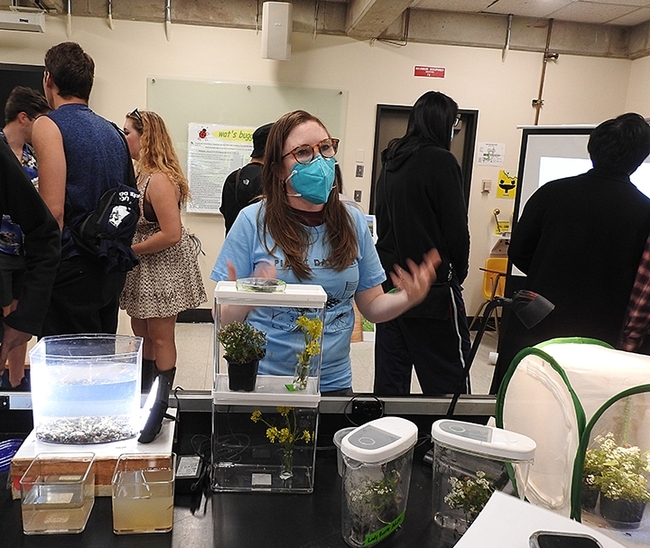
Adelaine "Addie" Abrams answers questions about agricultural entomology at the 2022 annual UC Davis Picnic Day activities in Briggs Hall. (Photo by Kathy Keatley Garvey)
Drip injection of Kerb evaluated
Richard Smith is the Vegetable Crop Production and Weed Science Farm Advisor and Michael Cahn is the Irrigation and Water Resources Farm Advisor. Both are with the University of California Cooperative Extension in Monterey County. Cultural practices for producing lettuce are changing with...
Lettuce growers hope weeding, research can counter devastating plant virus
Population explosion of insect vector contributed to $100 million in losses in 2020
While most Californians are wholeheartedly embracing the wet start to winter, one group is welcoming the rain more warily (and wearily) – lettuce growers in the Salinas Valley.
“It's a blessing, yes, we need the water,” said Tony Alameda, managing partner of Topflavor Farms, which grows a variety of produce in Monterey and San Benito counties. “But, oh gosh: with that water, here come the weeds, here comes the habitat, here comes all the other problems that go along with it.”
Weeds are overwintering havens for a tiny insect called the Western flower thrips, which in turn carries the impatiens necrotic spot virus (INSV) – a plant virus that caused $100 million in lost gross revenue for Salinas Valley growers in 2020.
The agricultural community called it “the biggest problem we've seen in a long, long time,” said Mary Zischke, facilitator of a task force convened by the Grower-Shipper Association to address INSV and a related affliction, Pythium wilt.
Widespread crop failure in 2020
Since INSV was first observed in the state in 2006, the virus – which poses no threat to people – triggered significant crop losses in 2019, leading up to a catastrophic 2020. As Alameda's lettuces began to show the telltale “bronzing” of the leaves, efforts to bag up or remove the infected plants had no effect on the virus' implacable spread.
“Nothing seemed to work,” he recalled, “and you just watch those fields collapse, week after week, until you're just like, ‘Ugh, there's nothing here to even harvest.'”
After “100% crop failure” that year in his prime fields at the heart of the Salinas Valley, Alameda tried to dodge the virus in 2021 – shifting lettuce plantings to San Benito County and instead using his most valuable land for unaffected crops such as cilantro, leeks and radishes. By decamping to San Benito, Alameda was able to harvest 70% of his usual lettuce yield.
Generally, growers enjoyed a reprieve from virus pressures in 2021. Even in this “good” year, however, about one-third of all lettuce plantings in the Salinas Valley had at least a low level of infection, according to Zischke.
“Since we were attributing a lot of our so-called good fortune – on having less damage this year – to the cooler weather, we know we can't count on that to get us out of this problem,” Zischke said. “All the models point to the fact that we're in a warming climate, so we were fortunate this year.”
More research needed on thrips
Heat waves were a major driver of the INSV disaster of 2020. Although researchers have established a link between warmer temperatures and population increases of thrips, science still has a lot to learn about those disease vectors.
“Thrips are something we're trying to understand as much as we can, but it's pretty tough because they're a little mysterious in the way they get around and where they overwinter,” said Richard Smith, a University of California Cooperative Extension vegetable crops and weed science farm advisor for the Central Coast region.
Smith – along with U.S. Department of Agriculture research entomologist Daniel Hasegawa and California State University-Monterey Bay plant pathologist JP Dundore-Arias – provided an INSV update during an Assembly agriculture committee hearing in December.
Recent studies have identified several weeds as key “reservoirs” of thrips, including malva, marestail, and hairy fleabane. The ubiquitous mustards, fortunately, appear to be poor hosts for thrips, although their pollen serve as potential food sources.
Controlling those weeds – which are beginning to spring up as the days lengthen – is a top priority during the winter months, according to Smith. Aggressive weed management in the preceding winter was an important factor in limiting the virus' spread in 2021.
And because weeds recognize no boundaries, experts are also urging managers of non-agricultural lands to keep their properties as clean as possible, including industrial sites, equipment yards and the edges of roadways – namely U.S. Route 101, which runs through the center of the valley. Some growers have been volunteering to weed their neighbors' vineyards.
“We're encouraging everybody – as best they can – to knock down known weed hosts; that's really critical,” Zischke said.
Search for long-term solutions
Within the grower community, there is “nervous optimism” for the coming year, said Alameda, as he continues to hope for an innovation that would aid in the fight against INSV – whether a more targeted pesticide application or a beneficial insect that could deter the thrips.
However, both Alameda and Zischke pointed to the breeding of more resistant lettuce varieties as the ultimate solution to INSV – albeit one that is years away.
“We have a lot of different types of lettuce that we grow, so to move resistance into all the different types of lettuce we grow throughout the season … that's going to take time,” Zischke explained.
Research funding from the state and USDA – as well as projects supported by the California Leafy Greens Research Program – can help expedite that process. But, for Alameda, the INSV crisis underscores the need for more resources and farm advisors such as Smith, who has spent more than three decades cultivating relationships and building trust within Salinas Valley communities.
Alameda would like to see a renewed focus on bringing “bright, young, passionate people who live and breathe this stuff” to the region, so growers are better equipped to handle the inevitable next calamity.
“Hopefully this is a wakeup call to all,” he said. “This is a valued industry – you have to take care of it; it cannot be taken for granted. The ‘salad bowl of the world' cannot rest on its laurels.”
Automated Weeders: Optimizing their value
Richard Smith is the UC Cooperative Extension Vegetable Crop Production and Weed Science Farm Advisor in Monterey, Santa Cruz and San Benito counties. Automated weeders remove weeds inside the three- to five-inch-wide uncultivated band left around the seedline by standard cultivation....

